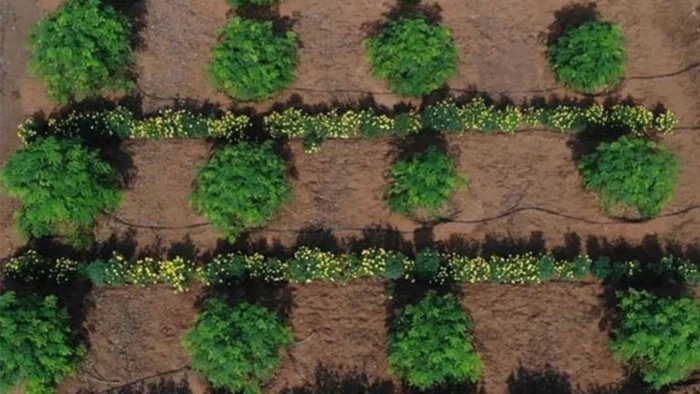Scientists in India have discovered a sustainable technique that significantly boosts the production of moringa, a superfood with the potential to address global hunger challenges. The study, led by researchers from the University of Reading, shows how planting flowers alongside crops can dramatically improve yield and crop quality for smallholder farmers.
Moringa: A Nutritional Powerhouse
Moringa oleifera, commonly known as the moringa tree, is a plant that holds top billing in the realm of superfoods or should be. This tree, native to parts of India, Africa, and Europe, is gaining global recognition for its remarkable nutritional profile and its potential in tackling food security issues on a large scale.
What sets moringa apart is the fact that every part of the plant is edible and packed with nutrients. Its leaves are a powerhouse of vitamins and minerals. They’re rich in vitamin C, providing seven times more than oranges, and have high levels of vitamin A, surpassing even carrots. Moringa leaves are also a great source of calcium, protein, and iron.

In addition to vitamins and minerals, moringa leaves are abundant in antioxidants, that help inflammation in the body. The leaves also contain essential amino acids, the building blocks of proteins, making moringa an excellent dietary supplement, especially in regions where protein sources are scarce.
The benefits of moringa extend beyond nutrition. Its drought-resistant nature makes it a resilient crop in the face of climate change, especially in arid regions where food scarcity is a critical issue. Moringa’s fast-growing and low-maintenance characteristics further enhance its appeal as a sustainable food source.
Highlighting the global importance of moringa, Associate Professor Carrie Waterman from the University of California, Davis, stated, “If there were a top 10 list of plants that are going to help feed the world over the next hundred years, I would say moringa should be on that list.” And Professor Waterman isn’t alone! Scientists and nutrition experts widely recognize the immense potential of moringa to address nutritional deficiencies worldwide.
The crop’s adaptability to various climatic conditions, combined with its rich nutritional profile, positions moringa as a key player in the global effort to end hunger and improve nutritional health. As the world faces the challenges of climate change and increasing population, moringa stands out not just as a superfood but as a symbol of hope for sustainable and nutritious food solutions.
And thanks to this research, farmers may just have an easier, and more beautiful way, to grow moringa along with pollinator-friendly flowers.
The Power of Flowers in Agriculture
In this study, the researchers implemented well-established temperate agroecosystem techniques in tropical moringa systems. They hypothesized that floral interventions, such as intercropping with flowers, would increase the diversity and abundance of flower visitors, thereby enhancing pollination services, and ultimately, the moringa yield and quality.
The study involved 24 moringa fields in Tamil Nadu, India. The researchers planted red gram (Cajanus cajan) as a border crop and marigold (Tagetes erecta) as an intercrop to enrich the floral resources available for pollinators.
This intervention led to a 50% increase in flower visitor abundance and a 33% increase in species richness compared to control fields without floral interventions. Remarkably, this resulted in a 30% increase in the yield of harvestable moringa fruits.
A Diverse Array of Pollinators
The study observed a total of 6450 flower visitors over two fruit-growing seasons. This included a diverse range of species – nine species of bees, five species of wasps, seven species of flies, and nine species of butterflies and moths. Bees were the most dominant group, making up over half of the flower visitors in both control and intervention sites.

Enhancing Pollination and Crop Yield
The results showed that the type of pollination significantly affected the percentage of flowers that set to fruit. Hand pollination led to a higher percentage of moringa pods compared to open pollination.
This finding was consistent in both control sites and sites with floral intervention.
Furthermore, the percentage of flowers resulting in harvestable fruit was significantly higher in sites with floral interventions than in control sites, and even greater under hand pollination.
Implications for Sustainable Agriculture
The study’s findings provide compelling evidence that floral interventions can effectively enhance flower visitor communities and pollination services in tropical agricultural systems.
More To Discover
This approach not only increases the yield but also contributes to the overall ecosystem health, including benefits like disease resistance, soil health, natural pest regulation, and greenhouse gas emission mitigation.
Source: Journal of Applied Ecology




















